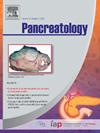Early selective enteral feeding in combination with active decompression of duodenum in treatment of moderate and severe acute pancreatitis – A proof-of-concept clinical study
IF 2.8
2区 医学
Q2 GASTROENTEROLOGY & HEPATOLOGY
引用次数: 0
Abstract
Background
Acute pancreatitis (AP) is a significant clinical challenge with rising global incidence and substantial mortality rates, necessitating effective treatment strategies. Current guidelines recommend pain and fluid management and early enteral feeding to mitigate complications, yet optimal feeding route remains debated.
Methods
We conducted a prospective, randomized, controlled trial at nine centers from October 2020 to May 2023, enrolling 154 patients with moderate to severe AP. Patients were stratified into biliary and non-biliary categories and randomized 1:1 to receive either standard of care (SoC) or SoC plus PandiCath®, a novel catheter enabling selective enteral feeding and duodenal decompression. The primary clinical endpoint (PCE) was a composite of de novo multiple organ dysfunction syndrome (MODS), infectious complications, pancreatic and intestinal fistula formation, bleeding, abdominal compartment syndrome, obstructive jaundice, and AP-related mortality.
Results
In the primary modified intention-to-treat analysis, PandiCath® significantly reduced the PCE compared to SoC alone (P = 0.032). The Relative Risk (RR = 0.469, 95 % CI 0.228–0.964) and Number Needed to Treat (NNT = 6.384, 95 % CI 3.349–68.167) indicated its substantial clinical benefit, primarily driven by reduced rates of de novo MODS and infectious complications. These findings were further supported by the evaluation of other populations, including the standard intention-to-treat analysis.
Conclusion
PandiCath®, facilitating targeted enteral feeding while isolating and decompressing the duodenum, demonstrates promise in improving outcomes for AP patients at risk of severe complications. Further studies are warranted to validate these findings and explore optimal timing and patient selection for this intervention.
早期选择性肠内喂养联合十二指肠主动减压术治疗中度和重度急性胰腺炎--概念验证临床研究。
背景:急性胰腺炎(Apute pancreatitis,AP)是一项重大的临床挑战,其全球发病率和死亡率不断上升,需要采取有效的治疗策略。现行指南推荐疼痛和液体管理以及早期肠内喂养以减轻并发症,但最佳喂养途径仍存在争议:我们于 2020 年 10 月至 2023 年 5 月在九个中心开展了一项前瞻性随机对照试验,共招募了 154 名中重度 AP 患者。患者被分为胆道和非胆道两类,并按 1:1 随机分配接受标准护理(SoC)或 SoC 加 PandiCath®(一种可进行选择性肠内喂养和十二指肠减压的新型导管)。主要临床终点(PCE)是新发多器官功能障碍综合征(MODS)、感染性并发症、胰瘘和肠瘘形成、出血、腹腔隔室综合征、梗阻性黄疸和 AP 相关死亡率的综合:在主要的修正意向治疗分析中,与单独使用 SoC 相比,PandiCath® 显著降低了 PCE(P = 0.032)。相对风险(RR = 0.469,95 % CI 0.228-0.964)和需要治疗的人数(NNT = 6.384,95 % CI 3.349-68.167)表明,PandiCath® 有很大的临床益处,主要是降低了新发 MODS 和感染性并发症的发生率。对其他人群的评估(包括标准的意向治疗分析)进一步证实了这些结论:结论:PandiCath® 可在隔离和减压十二指肠的同时促进有针对性的肠内喂养,有望改善有严重并发症风险的 AP 患者的治疗效果。有必要开展进一步的研究来验证这些发现,并探索这一干预措施的最佳时机和患者选择。
本文章由计算机程序翻译,如有差异,请以英文原文为准。
求助全文
约1分钟内获得全文
求助全文
来源期刊

Pancreatology
医学-胃肠肝病学
CiteScore
7.20
自引率
5.60%
发文量
194
审稿时长
44 days
期刊介绍:
Pancreatology is the official journal of the International Association of Pancreatology (IAP), the European Pancreatic Club (EPC) and several national societies and study groups around the world. Dedicated to the understanding and treatment of exocrine as well as endocrine pancreatic disease, this multidisciplinary periodical publishes original basic, translational and clinical pancreatic research from a range of fields including gastroenterology, oncology, surgery, pharmacology, cellular and molecular biology as well as endocrinology, immunology and epidemiology. Readers can expect to gain new insights into pancreatic physiology and into the pathogenesis, diagnosis, therapeutic approaches and prognosis of pancreatic diseases. The journal features original articles, case reports, consensus guidelines and topical, cutting edge reviews, thus representing a source of valuable, novel information for clinical and basic researchers alike.
 求助内容:
求助内容: 应助结果提醒方式:
应助结果提醒方式:


